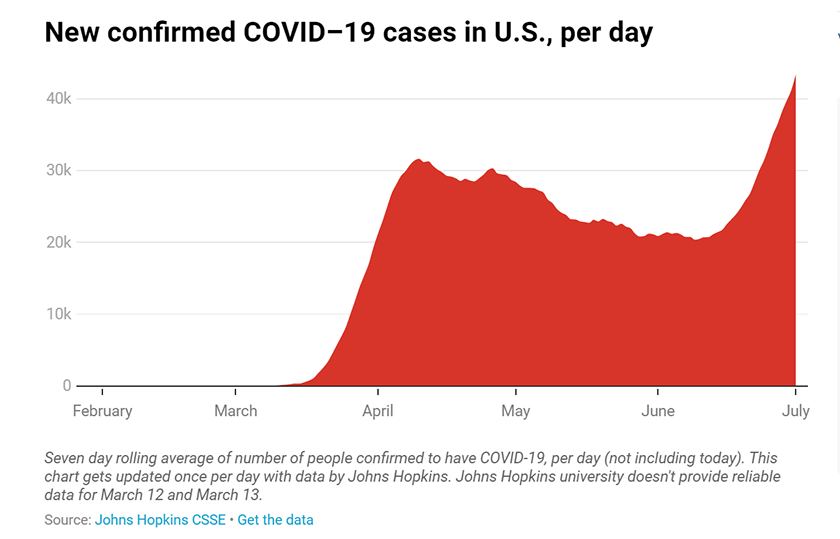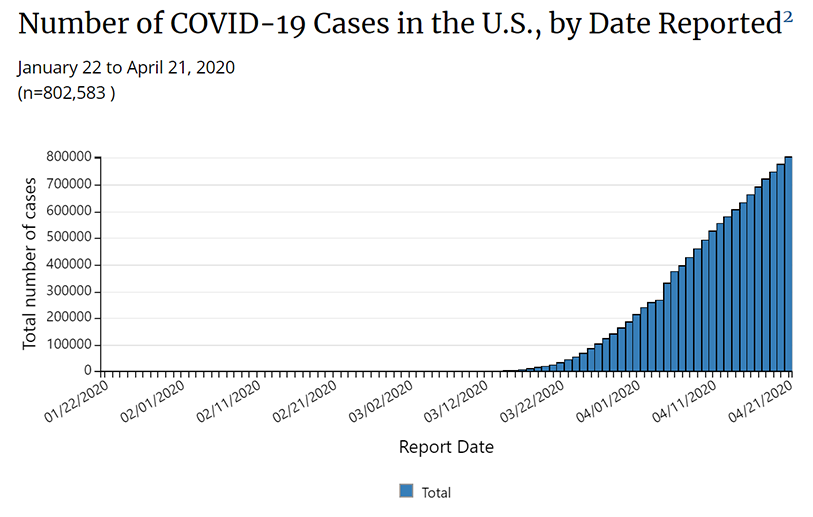This blog was originally published on April 23, 2020. Since then, the US has seen a decline followed by surges of the virus in many states. However, this isn’t the second wave, but a continuation of the first wave. This trend is displayed in the graph below.

Other countries have experienced a second wave already. After an outbreak of over 300 cases last month, China was able to get their second wave under control in 21 days with no deaths, according to Time.
They successfully quelled the second wave by closing down schools, bars, and beauty parlors, increasing testing, and placing residential areas on lockdown based on contact tracing results. If a person came into contact with an infected individual, they will have to quarantine for 28 days because authorities fear the virus might be more contagious.
The U.S. can look to other countries as examples, as many have successfully responded to their second waves with tools such as increased testing, social distancing, and contact tracing. This can help the U.S. prepare in the instance of a second wave.
____________________________________________________________________________
Most of the country is still in the midst of battling COVID-19. Social isolation regulations, masks, frequent hand washing, and closed businesses have become the norm. According to the CDC, the COVID-19 curve for our nationwide infection rates has not yet flattened (illustrated by the graph below).

â€
As our communities, led by emergency managers, first responders, and healthcare workers, continue to battle COVID-19, we also have to think towards the future. Many experts are saying that we will likely have a second wave of COVID-19.
Fortunately, we have learned a lot from this first wave of the virus, but it’s important that we remain vigilant, mitigate, and prepare for a future, secondary COVID-19 outbreak.
The Second Wave
Robert Redfield, the CDC Director, has spoken out about the likelihood of a second wave of the COVID-19. Redfield stated that a second outbreak is not only a possibility, but that “next winter [could] actually be even more difficult than the one we just went through.”
The reason for the increased challenges associated with wave two is because COVID-19 would likely be returning as the regular flu season is underway. As many can imagine, this would be a hard hit for hospitals who are already struggling for resources during this initial wave of COVID-19.
USA Today also reports about the dangers of a second wave of COVID-19. The article quotes Peter Marks, the director of the U.S. FDA’s Center for Biologics Evaluation and Research, which oversees vaccines. In it, he says that without a vaccine “it’s unfortunately not unlikely that we may see a second wave or even a third wave.”
Some are asking whether people who have already contracted the virus will be immune to it during this possible second wave. Some experts believe that because the virus is similar in nature to SARS and MERS that infected people will have some immunity.
If this is the case, says Gregory Poland, a professor of medicine at the Mayo Clinic and editor-in-chief of the journal Vaccine, then “Wave 2 will be in the interior of the county where there are a lot of susceptible people.”
Right now, during what could be the first wave one, the pandemic is primarily hitting the coasts of the nation, meaning more people in these areas could be immune during a second wave. It follows that the center of the country would be harder hit the second time around.
It’s terrifying to think that the fight against COVID-19 is far from over, but being informed about the realities of the virus can help us be prepared for what’s coming next and fight this pandemic to the best of our ability.
Mitigate, Prepare, Respond
There are many ways to get ready for a second wave while still fighting the first outbreak of COVID-19. Wave one has taught us a lot about processes, procedures, and communication methods that can contribute to the overall success of an organization.
Redfield, the CDC director, has recommended that people start with “social distancing and scaling up testing and contact tracing.”
Social distancing, as well as precautions such as face masks and hand washing, are accessible ways that all members of the general public can join the fight against COVID-19.
Increased testing and contact tracing can help track infections. By identifying individuals who are infected and tracing the path of infection, healthcare officials can have a better idea of who was potentially exposed and quarantine them before they have the chance to infect others.
Another key component of being prepared for a second wave of COVID-19 is after action reporting (AAR) on the first outbreak. Data collection is key so that data can be later analysed. What went well with your response? What would you change for next time? What type of information were you able to gather, and how?
These questions are essential for fueling future responses because they tell your organization what needs to be done to be as prepared as possible. AAR is a guidebook for facing a second wave of COVID-19.
How Technology Can Help
There are many options for technology platforms that can assist with communications and reporting around a response. Veoci has already established and implemented over 400 solutions around COVID-19, so we give you access to all the tools you need in one place.
In addition to your physical emergency operations center (EOC), pandemics require virtual EOCs which create an online meeting space where communication is promoted and data is inherently collected. See our blog on virtual EOCs for more information on what this looks like.
After action reporting (AAR) is also streamlined when you have a platform that naturally collects and aggregates data from your forms and workflows. Display data in charts with the click of a button, view color-coded data on our GIS mapping feature, our look through threaded, archived conversations to find key information.
Technology is an excellent tool for tracking the infection, keeping people informed, and streamlining communication. It will also create running documentation of your response, so you know what you need to do to get ready for phase two of COVID-19.
Responding to COVID-19 Together
Technology can support communication efforts and make it much easier to track and report data, and help us prepare for what’s coming next.
No one wants to think that this first COVID-19 outbreak is just the beginning, but being realistic about the future and planning accordingly can help save lives. Getting everyone on board is crucial to ensure a nationwide response.








